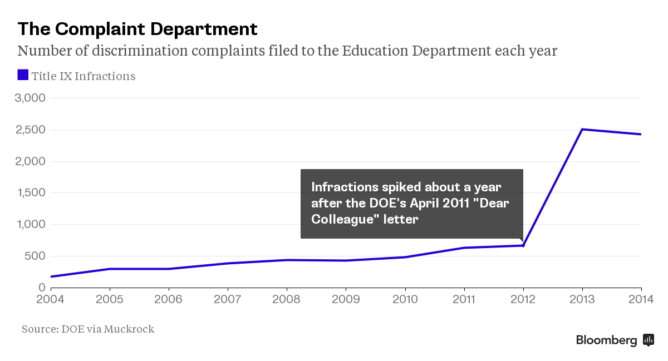A Title IX investigation is more than a regulatory requirement—it’s a critical moment of accountability. When a report of sex-based harassment, discrimination or misconduct is filed, your response needs to be prompt, fair and consistent. In other words, your Title IX process can’t just be a policy.
This guide outlines every step of a compliant Title IX investigation. Whether you’re starting from scratch or tightening up what you already have, we’re here to help your team respond with clarity, speed and confidence every time.
What Is a Title IX Investigation?
A Title IX investigation is the formal process triggered when there’s a report of sex-based misconduct tied to an educational program or activity. It’s not optional—it’s a legal obligation under Title IX of the Education Amendments of 1972 for any institution that receives federal funding.
But it’s also more than a mandate. A strong Title IX investigation process sends a clear message: Your educational institution will protect its community, hold people accountable and never ignore harm—and not having the data is not an excuse.
When Should You Initiate a Title IX Investigation?
The clock starts as soon as your institution has actual knowledge of potential Title IX misconduct. You must act, and delays don’t just raise questions—they also increase risk.
It’s time to initiate the Title IX investigation process when:
- A formal complaint is filed or signed by the Title IX Coordinator
- Someone reports alleged misconduct by a student or employee
- The behavior occurred within a school program or activity
- The allegation aligns with Title IX definitions of sexual harassment or violence
If any of these apply, it’s time to launch a Title IX investigation.
What Types of Misconduct Does a Title IX Investigation Address?
The Title IX investigation process is built to encompass a wide range of serious misconduct, including:
- Sexual harassment or assault
- Gender-based discrimination
- Unwelcome sexual advances
- Dating or domestic violence
- Stalking
If it happens within the scope of a school-affiliated environment, it falls under Title IX. A structured, consistent Title IX investigation process is how institutions protect their communities and uphold accountability.
Why the Title IX Investigation Process Matters
Title IX lays out the legal foundation. But your process is what builds trust. A well-executed Title IX investigation shows your students, staff and faculty that you’re serious about safety, fairness and follow-through. And when you conduct a Title IX investigation, you’re inevitably sending a message to your community. Make sure that your message is the right one.
There’s also an opportunity for cross-functional collaboration with Title IX investigations. Title IX and HR teams often work together with shared systems and consistent standards to ensure institutions go beyond meeting expectations.
How Does a Title IX Investigation Work?
Every Title IX investigation should follow a clear, step-by-step process. That structure ensures consistency, protects all parties involved and helps your institution stay compliant and defensible.
Here’s how it works:
Step 1: Appoint a Title IX Coordinator
Every institution needs a designated Title IX Coordinator to oversee investigations and ensure compliance. This person leads the process, coordinates training and serves as the primary point of contact for all Title IX matters.
Your Title IX coordinator must be:
- Well-trained and impartial
- Responsible for managing procedures and timelines
- Equipped to guide cross-functional teams through the process
Step 2: Notify All Parties
Once a formal complaint is filed, notify both the complainant and the respondent. That notice must include:
- A clear description of the allegations
- The accused conduct
- The steps that will follow
- Information about each party’s rights and support resources
This step reinforces due process, sets expectations and ensures transparency throughout the process.
Step 3: Gather Evidence and Conduct Interviews
Start your investigation by collecting evidence. This includes:
- Interviews with the complainant, respondent and any witnesses
- Review of documents, messages, records or other relevant evidence
Conducting an interview isn’t easy—especially when the subject matter is sensitive or deeply personal, as Title IX investigations often are. To get to the core of the situation, your questions need to be:
- Open-ended
- Free of assumptions
- Structured to move from broad to specific
Ask each party to describe the situation in their own words. Then, request the names of others who may have relevant insight.
Most importantly, document everything thoroughly and store it in one centralized, secure location. That’s why investigation management software is a must— HR Acuity makes it easy to keep documentation in one place.
This part of the Title IX investigation process sets the stage for everything that follows. It must be methodical, unbiased and well-documented.
Step 4: Analyze the Evidence
Once information is collected, the Title IX Coordinator or investigation team conducts a thorough review. Every detail is assessed against the standard of proof required — usually the “preponderance of the evidence.”
In the context of a Title IX investigation, “preponderance of the evidence” means that, based on the information gathered, it is more likely than not that the alleged conduct occurred. In other words, if there’s even slightly more credible evidence supporting the allegation than opposing it, that threshold is met.
Ask:
- Does the alleged conduct meet the Title IX threshold?
- Is the evidence consistent and credible?
- What does the full context reveal?
This analysis determines whether disciplinary action is warranted or if the case should be closed.
Step 5: Make a Determination
At this point, a decision-maker (someone other than the investigator) must review the findings and issue a determination.
If a violation is confirmed, appropriate action must follow. If not, both parties are notified, and the case is closed (unless there’s an appeal). Every decision must be documented, unbiased and legally defensible.
Step 6: Share the Outcome
Share a written report with both parties. It must include:
- The allegations investigated
- Evidence considered
- The final finding
- The rationale for the decision
This step ensures clarity and allows both parties to review or challenge the outcome.
For comprehensive documentation and reporting guidance, refer to our investigation report template, which can assist in structuring detailed and effective reports for Title IX investigations.
Step 7: Take Action
If the findings confirm a Title IX violation, the institution must act. Remedies may include:
- Disciplinary measures
- Academic or workplace accommodations
- Policy updates
- Campus-wide prevention efforts
Each party must also be informed of their right to appeal and how to do so if they’d like to move forward with it.
Best Practices for Managing a Title IX Investigation
A Title IX investigation isn’t just a process — it’s a responsibility. How you manage it can shape campus culture, mitigate legal exposure and ensure student safety. These best practices help ensure your Title IX investigation process is fair, thorough and defensible.
Make Reporting Accessible
Create clear, well-publicized ways to report misconduct, including anonymous reporting options. A visible, transparent system encourages reporting and signals that your institution takes all allegations seriously. Our anonymous reporting hotline prioritizes accessibility, with AI, live agent and online reporting options. Employees can decide if they wish to submit an anonymous or named report, and we support 35 languages in over 50 countries.
Act Quickly, But Don’t Rush
Delays create confusion, risk and harm. Launch investigations promptly, follow timelines and communicate regularly with all parties to set expectations.
Keep Parties Separated During the Process
Minimize or eliminate contact between the complainant and respondent while the investigation is ongoing. Safety and well-being must remain a priority at every stage.
Document Everything
Log every email, interview and piece of evidence. Use investigation management tools, like HR Acuity, to track timelines, maintain attorney-client privilege and prepare for potential audits or legal review.
Offer Support Resources
Both complainants and respondents may need access to counseling or academic accommodations. Make sure you provide these resources.
Ensure All Involved Understand Their Rights
Make sure that everyone involved in the process has read and understands their rights as stipulated by Title IX before speaking with investigators or providing any documents. This includes students, faculty members, administrators, staff members and parents.
Enforce Appropriate Consequences
When misconduct is confirmed, take decisive action. That could mean suspension, expulsion, removal from duties or additional training — whatever aligns with your policy and the severity of the violation.
Review with Legal
Before submitting materials to the Office for Civil Rights or law enforcement, have legal counsel review your documentation. A strong legal review helps protect institutional integrity and reduce risk.
Train Your Teams
Make sure everyone involved (from Title IX Coordinators to HR professionals) is trained on Title IX regulations, trauma-informed practices and proper investigation techniques.
How to Work With the Respondent in a Title IX Investigation
The respondent (the person accused of violating Title IX) has rights. And how you treat them matters. Your investigation must be fair, neutral and free of assumptions. That includes how you engage with the respondent from the start.
Inform Them Clearly
Provide a detailed notice outlining the allegations, the steps of the investigation and their rights throughout the process.
Maintain Neutrality
Do not assume guilt. The purpose of a Title IX investigation is to gather facts, not to pass judgment. Let the evidence guide the outcome.
Allow for Support
Respondents have the right to bring an advisor, including legal counsel, to interviews or hearings. Make this clear in writing.
Share Evidence
As part of due process, the respondent must have access to the evidence being considered—and a chance to respond before any findings are made.
Handle Difficult Situations Professionally
Even in high-stakes or emotionally charged cases, professionalism is key. Treat the respondent with dignity while maintaining firm boundaries and a consistent process.
How Long Does a Title IX Investigation Take?
There’s no one-size-fits-all answer. A Title IX investigation can last a few weeks or stretch over several months. The timeline depends on the complexity of the case, the number of witnesses and how quickly information is gathered.
While federal guidance encourages prompt resolution, the real goal is thoroughness. Rushing through key steps (or delaying unnecessarily) can damage credibility and legal defensibility. Institutions should aim to complete the investigation and resolution process within 60 to 90 days when possible, while allowing flexibility based on case specifics.
Clear communication about expected timelines helps manage expectations and reduce confusion for everyone involved.
Manage Title IX Investigations With HR Acuity
Whether you’re responding to a formal complaint, navigating complex allegations or building your Title IX investigation process from the ground up, HR Acuity is here to help. Our investigation management platform gives your team the tools to stay compliant, consistent and audit-ready—all in one place.
You’ll be able to:
- Centralize documentation across multiple cases
- Maintain investigation timelines and trigger workflows
- Flag trends across student and employee misconduct
- Collaborate across ER, HR and Title IX teams without duplicating effort
- Secure legal review and maintain privilege with proper labeling
A well-run Title IX investigation isn’t just about compliance; it protects your people, your institution and your reputation. Using software designed for defensible investigations helps ensure consistent, equitable issue handling—regardless of how complex the case is.
Ready to strengthen your Title IX process? G2 users say, “HR Acuity is just what we needed for data integrity and ease,” and rely on it to manage everything from employee relations and investigations to Title IX and ADA compliance—all in one place.
Take a Curiosity Tour to see how HR Acuity helps institutions like yours handle sexual misconduct allegations with clarity, consistency and care.




